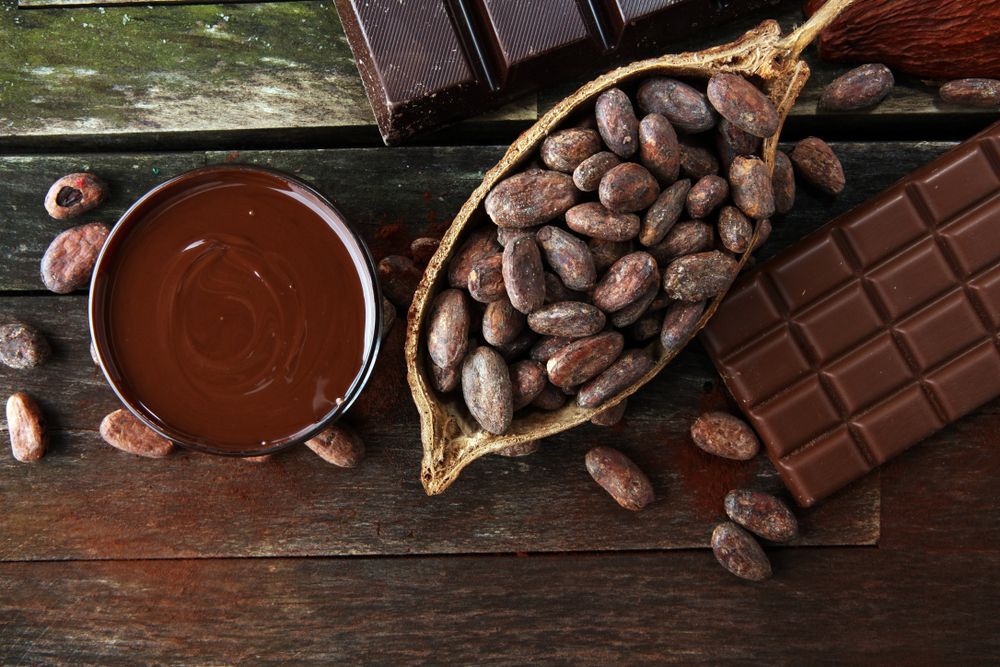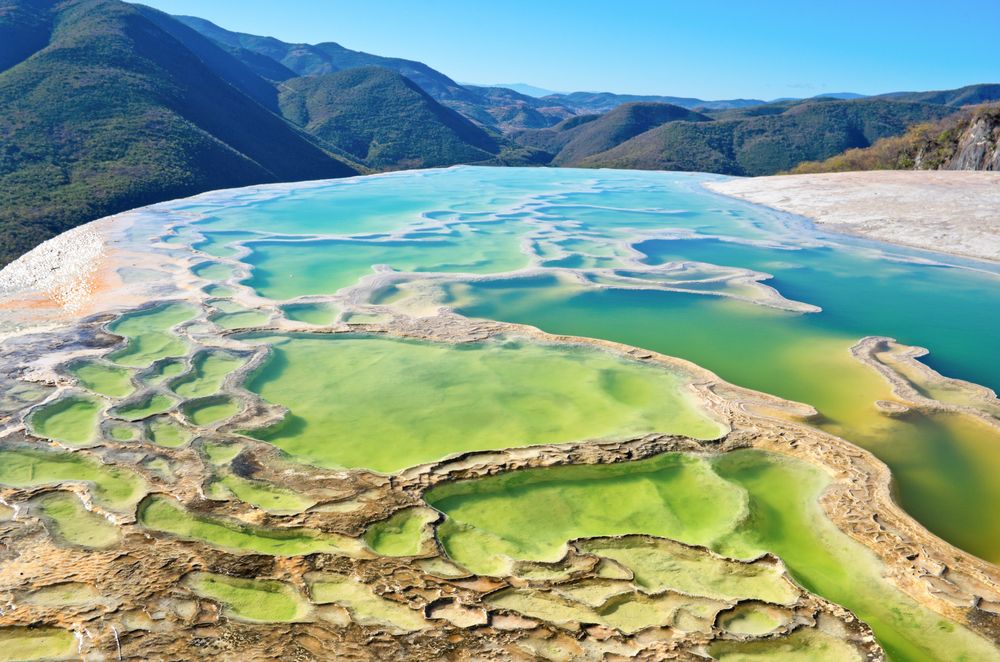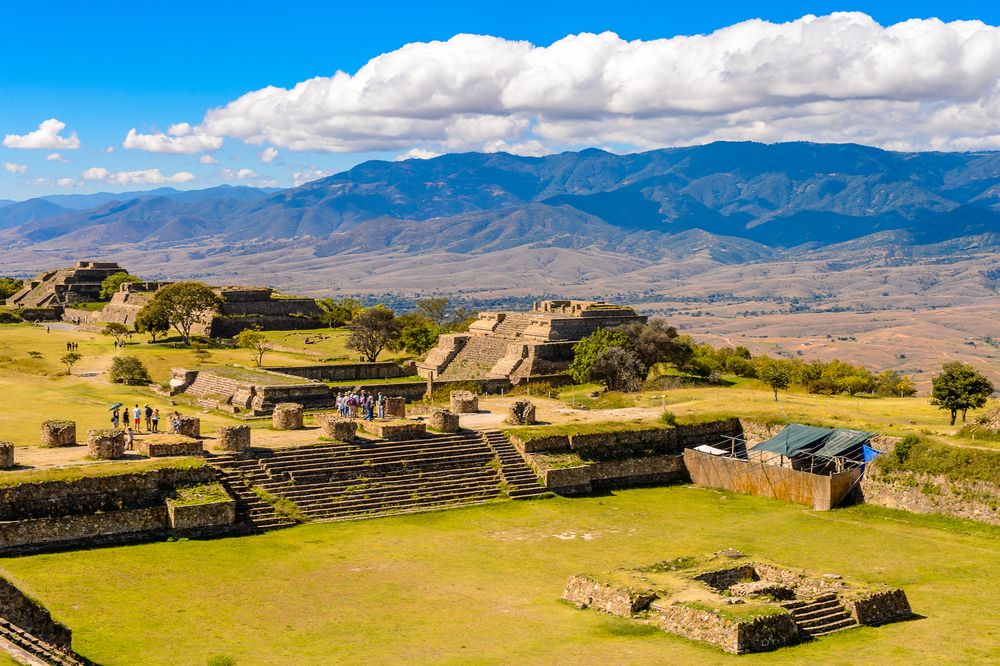Travel in Mexico: Oaxaca | donQuijote





Oaxaca is about as far as you can get from the typical Mexican beach destination, but what it lacks in waves and sand it more than makes up for in culture. This culinary dreamscape weaves traditions going back thousands of years into the colorful patchwork of a modern city renowned for its unique blend of contemporary art and ancient craftsmanship.
Read this guide in Spanish here.
Known as the land of the seven moles (pronounced MOH-leh), Oaxacan cooking attracts tourists to the city from all over the world. If you’ve tried the dark brown, chocolaty mole sauce outside of Mexico and have concluded that mole is not for you, we encourage you to give it another shot. You have seven delicious types to choose from: negro (the most famous), amarillo, coloradito, verde, chilchilo, rojo (the spiciest), and manchamanteles (the “tablecloth-stainer”). Contrary to popular belief, not all moles contain chocolate, so if you don’t have to mix sweet and savory if you don’t want to!

Speaking of chocolate, Oaxaca is a haven for chocoholics. Although it’s not a major growing region, Oaxaca has a love for cacao that dates back thousands of years. The ubiquitous Oaxacan hot chocolate is a drink for both special occasions and everyday life, and it’s guaranteed to warm your heart. Mayordomo and La Soledad are two chocolate institutions with stores and stands where they will grind the cacao beans for you.
Try these and other local treats — tamales, tlayudas (sometimes called Oaxacan pizzas), chapulines (spicy grasshoppers!), quesillo string cheese, and so much more at one of the local markets in Oaxaca.

If you’ve got food on the mind and want to get a good look at all the options, head to Mercado de Abastos, Mercado de Benito Juarez, or Mercado 20 de Noviembre and prepare to be amazed. Meat lovers won’t want to miss this last market’s pasillo de carnes asadas (grilled meats aisle), where you pick out the raw meat and spices you want and watch as they get cooked over hot coals with vegetables and served in a basket with salsas and fresh corn tortillas. Markets often sell colorful handicrafts, flowers, and other products in addition to food, making them the perfect place to go shopping before and after your meal. You should also check out the busy Central de Abastos, an enormous, bustling open-air market.

Thanks to its large indigenous population, Oaxaca has a vibrant folk art tradition. You’ll find beautiful black pottery, colorful woven rugs and textiles, and cheerful alebrijes (brilliantly painted wood carvings in the shape of fantastical animals) being sold in markets and stands around the city. The Mercado de Artesanías is a good place to start.
As you walk around the city, you’ll find a lot of modern street art, much of which is political. Even if you don’t speak Spanish (which you can remedy by taking classes at don Quijote in Oaxaca!) and can’t fully understand the message, you’ll enjoy the bright colors and passion that comes through visually.
Espacio Zapata, founded by the Assembly of Revolutionary Artists of Oaxaca (Asaro) during major political turmoil in 2006, is a workshop and gallery that hosts exhibitions, events, and workshops, and the murals decorating the outside of the building are in constant flux.
You’ll also find many art galleries with a mixture of traditional and contemporary art, which you can pop in and out of when they cross your path. If you like to have an exact destination, set your sights on one of Oaxaca’s many art museums, with collections that range from the pre-Columbian era to the futuristic.

If you want to take a swim overlooking a luscious green valley, soaking in natural springs and contemplating a petrified waterfall in the distance, you’ll be happy to hear that the infinity pools of Hierve el Agua are only an hour-long bus ride away. This is perfect place to cool off and take in the natural beauty of your surroundings.

To learn about Pre-Columbian civilizations, Monte Albán is a spectacular must-see. Located less than half an hour from Oaxaca, this city was home to the Olmecs, the Zapotecs, and the Mixtecs over a period of more than one thousand years and had more than 25,000 inhabitants during its peak as the Zapotec capital.
Remember, these suggestions are just the beginning — we haven’t even mentioned Oaxaca’s central plaza, colonial architecture, festivals, or mezcal culture. You’ll have to go to Oaxaca to discover it for yourself!
Do you like to travel to find the best places to learn Spanish? It's important to know the best places to learn Spanish with culture and activities for the users.

Thinking about traveling to find the best places to learn Spanish but don't know where to start? Look no further and let us help you find the best Spanish places to visit!
Spanish is spoken in many different countries and each one has a different appeal for visitors: whether it's history, nature, or culture you're interested in, you will find your perfect match. Let's explore together different destinations where learning and practicing your Spanish won't be a problem. Here are the seven best places to learn Spanish and donQuijote has a school in each one.
You know, the Spanish language comes from Spain, so wouldn't it be a great place to start? While there are differences between the varieties of Spanish used in Spain, everyone can still communicate with each other.
The Spanish language you learn in Spain is different to South American because of the different ways it is spoken. But when you learn Spanish in Spain, you will be able to communicate in any country that speaks the same language. You may practice your knowledge before studying abroad in Spain by listening to the radio, watching your favorite show in Spanish, or download a Spanish app on your smartphone.

Madrid is the capital of Spain and is known for its energetic culture, tapas and great ambiance. Most locals are very friendly and like tourists who want to learn to speak their language. You can start your journey with donQuijote and learn Spanish in Madrid. This city is the 6th most populated place in Europe and its clearly spoken accent is just great for learners.
Spanish classes in Madrid are very interactive, and everything you study in the classroom you will put into practice with a friendly local. What better way to learn Spanish in Madrid than over a glass of wine and free tapas?
On the other side, you can choose to study and learn Spanish in Barcelona. Barcelona is surrounded by sunny beaches and its great food makes it a long-standing favorite destination for tourists.
Barcelona could be the best place to learn Spanish because of its melting pot of individuals and their cultural blend. So you can take a Spanish course in Barcelona to live a cultural experience as you practice the language with native locals. This course will also help you experience a new lifestyle by making new friends and having fun in a new language.
Just imagine after your Spanish classes in Barcelona, you and your new friends head out to eat with an incredible view of the Mediterranean Sea. Sounds incredible!
Truly immerse yourself in the Mexican culture and traditions through the language in Latin America by trying out one of our Spanish immersion programs in Mexico. Learn Spanish in Mexico throughout your daily routines and take advantage of the opportunity to practice your Spanish in your everyday life.

DonQuijote offers you three destinations to learn Spanish in Mexico: Playa del Carmen, Oaxaca or Guanajuato.
Our favorite place is Playa del Carmen: a perfect destination for a Caribbean getaway with beautiful beaches, lush forests and incredible weather all year round. A cosmopolitan city where you can practice your Spanish and while taste cochinita pibil or panuchos.
Another of the best Spanish places to visit in Mexico is the state of Oaxaca, in the southwest of the country, which has a coast bathed by the Pacific Ocean. It is one of Mexico's top destinations, thanks to its rich culture and amazing gastronomy. You will make long-lasting friends and open new doors for your future while you study the language in Mexico with donQuijote.

Surround yourself with gorgeous nature! Come and learn Spanish in Costa Rica and have fun while doing it. This country has amazing sights and here you will be able to study new vocabulary while you're ziplining through the jungle. Study Spanish in Costa Rica while enjoying some natural hot springs or visiting an adventure park. It's the most biodiverse country on Earth, so keep an eye on its amazing wildlife! Discover another of the best Spasnih places to visit in Latin America with don Quijote.
Love red wine and advanced cuisine of all types of food? You can venture off after your classes and indulge in the culture. Argentinians are famous for their distinctive and captivating accent, and they love exchanging and learning new vocabulary words with tourists. So, feel at home and make the most of your stay while you learn Spanish in Argentina and share mate with your friends.

Buenos Aires is known for its high population, and its cultural scene makes it one of the world’s top destinations. Many of the Spanish schools in Buenos Aires offer immersion to help students experience the real Argentina. Since language and culture go side by side, what better way to learn Spanish in Buenos Aires than a highly customized program that tailors your interests and helps you learn faster?
Everything you have heard or seen on TV about this country you must delete it from your memory and start off fresh: a lot has changed since the 90s. Spanish schools in Colombia are surrounded by the country's lush landscape and offer many opportunities to practice your new linguistic skills. One of the many reasons to learn Spanish in Colombia is that the locals clearly pronounce their words and speak slowly, which makes it very easy to understand.

Gain the ultimate experience and learn Spanish in Bogota or Cartagena while you get to know the local traditions. The Spanish schools in these cities will teach you how to communicate in supermarkets, restaurants, and other places where you will want to talk to people on an everyday basis.

This historical and vibrant country is known for its music, art, and culture. Take a tour around the city and study Spanish in Cuba in a way you never expected. Jump inside a 1950s car and see vintage art pieces on your way, and don't miss the breathtaking architecture that awaits you just around any corner in Havana, Trinidad or Santiago de Cuba. Travel to Cuba while you learn to dance through old Havana and, of course, fall in love with the locals' Caribbean accent.

Explore the beauty of the rainforest and wildlife while you learn Spanish in Ecuador. Most locals are very open to helping international travelers around the area. A good Spanish school in Ecuador prepares you for basic conversations and how to travel around cities like colonial Quito with no problem. People from Ecuador speak slowly and clearly so it doesn't matter if you're an absolute beginner, you won't struggle to communicate. So, come and study Spanish in Ecuador, it will be the experience of a lifetime!
These are just the seven best places to learn Spanish, but you will find countries and cities all over the world where mastering this language will be fun and unforgettable. If you want to start your adventure in the language, don't hesitate any longer and come with don Quijote to study Spanish in Spain or Latin America.

If you google "the city of Oaxaca" you will immediately see links to travel blogs with titles like, "10 things to do in Oaxaca, the most fun city in Mexico," "Oaxaca, my favorite city in Mexico" and so on. So it may be clear, Oaxaca is a must-see destination in Mexico!
Oaxaca (pronounced o-wa-ga-ka) de Juárez is the capital of the Mexican state of Oaxaca and is a UNESCO World Heritage Site. The city is characterized by small alleys, plazas with cozy terraces, brightly colored houses and colonial buildings. But also the landscape surrounding the city is fantastic. Oaxaca offers you a perfect combination of city and nature.
What you should definitely do while in Oaxaca is visit one of the many markets. At the Mercado Juárez you will mostly meet locals doing their daily shopping. A fun way to check out what's in their shopping basket. You should visit the Mercado Sánchez Pascuas with an empty stomach, because that is a large indoor food market where you can order the most delicious Mexican dishes.
A typical Oaxacan dish is tlayuda a large crispy tortilla with a base of beans and a topping of guacamole, tomato, cheese and lettuce. By the way, this is a dish that can be seen as a full meal, because after this tlayuda you are guaranteed to be full. So if you want to be able to taste more things, share it with your travel companions!
In the middle of the city stands the Catedral which is also described as the most imposing structure in Oaxaca. The construction of the church took hundreds of years and the result is impressive. The richly decorated interior of the church is magnificent and well worth a visit.
If you want to go out at night, go to Café Central. A club where, in addition to DJs, many bands perform live. Every night of the week there is something going on, from dance parties to movie nights or a jazz concert by a Big Band.
From Oaxaca you can also plan fun excursions. The temple ruins of Monte Alban are really worth seeing. But don't skip the ruins of Mitla and a hike along the Pueblos Mancomunados (eight authentic Zapotean mountain villages) if you have the chance. On the coast - Yucatán - you can also have a great time and discover the flora and fauna of the sea while snorkeling or diving.
Although Oaxaca is called the cultural heart of Mexico, mass tourism is not (yet) very present. This allows you to enjoy the local culture, way of life and experience Mexico in a unique way.
And to make your trip to Oaxaca even more enjoyable, you can also take a Spanish course at our don Quijote school in Oaxaca where you can start a course every Monday of the year regardless of your current level!

Oaxaca is one of the largest cities in Mexico, and is the capital of the state of the same name. It is a city that is particularly popular for its diverse traditions and cultures, as well as its historical past. Oaxaca is also especially famous for its food, indeed it has been hailed as “Mexico’s culinary capital”.
One of the most exciting cities in Mexico, Oaxaca enjoys a mixture of indigenous and colonial cultures
With numerous historic sites and a World Heritage Site within its walls, Oaxaca, Mexico has some of the most beautiful pre- and post-colonial relics to be found in Mexico
The site of Oaxaca has been inhabited by indigenous populations for centuries, and following the Spanish conquest in 1521 the city itself began to be built. A Spanish commander arrived with some Aztecs who constructed the first houses and churches, and they began to build the cathedral in 1522. From this point there were several disputes between Hernán Cortes, who lead the conquest of Mexico, and those that settled in Oaxaca; indigenous and Europeans alike. Following these disputes, it was not until 1532 that King Charles of Spain declared Oaxaca as a city to be ruled by the Spanish monarchy directly, rather than Cortes; this was deemed a huge victory for the population of the city as they were able to retain the traditions and architecture that today make Oaxaca so special. Mexico gained its independence from the Spanish in 1821, and naturally Oaxaca gained its independence at the same time.
Today, Oaxaca is one of the most popular cities in Mexico for tourists. Typically it is most popular in the summer, thanks to the temperate weather, but due to its location near the equator, Oaxaca has a pleasant climate all year round and attracts tourists in all seasons. It was named a Cultural Heritage of Humanity city by UNESCO, thanks to its innumerable historic and culturally important buildings.
Some of the most notable sites in Oaxaca are the Plaza de la Constitución where you can sit in a café and enjoy traditional Oaxacan foods. Similarly, the pre-colonial city of Monte Albán is particularly famous, as it houses artefacts from thousands of years ago. This ancient city was also named a UNESCO World Heritage Site, along with Oaxaca itself. The Plaza de le Danza y Jardín Socrates is also very popular. With beautiful gardens in the centre of the city where artists often go to display their work, and a square that hosts dances and festivals, it is a particularly bustling area and very popular with tourists.
The culinary scene in Oaxaca is particularly famous. The Mercado 20 de Noviembre (20th November Market) is well known for its food products that are made freshly every day and showcase Oaxacan cuisine; moles (traditional Mexican sauces), chapulines (fried grasshopper) and pan de yema (egg bread). Much of the food in Oaxaca is influenced by indigenous and Spanish recipes, while it also has connections to the religious and family-oriented nature of Mexican culture. Tables are often put down the middle of the street, usually on Sundays and Holy Days, and the whole community comes together to celebrate; the traditional Oaxacan dishes feature greatly on these feast days.

Mexico is an enormous country, where cultures with thousands of years of history live together with a modernity that keeps an eye to the north while continuing to treasure its traditional values. It's a country to get away to and enjoy: dreamy beaches (on the Caribbean and the Pacific coasts), impressive pre-Columbian era archeological ruins, and unique traditions. Also, Mexican folklore is widely known and appreciated, not to mention its cooking!
Let's take a look at ten recommendable places for relaxing and enjoying weather and the friendliness of the Mexican people, in Spanish of course. Creating a list of recommended places always presents the problem of where to begin. That's why in our attempts to be fair, we're relying on good old fashioned alphabetical order...
On the coast of the state of Guerrero, 390 kilometers from Mexico City, this is one of the most internationally known vacation destinations in Mexico. The Acapulco Bay, in all its magnificent beauty, invites us to dive into its warm waters. (Nearest don Quijote Spanish School in Mexico: Oaxaca).
This is without a doubt the number one vacation destination in Mexico. Located in the state of Quintana Roo, (the eastern-most state of the country) this city has quickly developed from a small isolated fishing town into the most important tourism center in Mexico, which guarantees an international atmosphere and first-class hotel facilities.
An example of just how popular this destination is; the airport here receives an average of 200 international flights per day. White sand beaches, modern hotel resorts and a subtropical climate with an average temperature of 270 C. all year round, all invite us to relax here.
We find this colonial gem, capital of the state with the same name, in Mexico's interior. The city of Guanajuato reached a high level of development in the colonial age due to gold and silver found in the region. In the beginning of the 19th century, Guanajuato witnessed a great victory for revolutionary insurgents, headed by the priest Father Hidalgo, over Spanish troops when they took over the Alhóndiga de las Granaditas and massacred troops and civilians who'd taken refuge inside the building. It's one of the most relevant moments in the country's history.
Today, Guanajuato is an important university city and home to the Festival Cervantino, probably the most important artistic presentation in Mexico, and even in all of Latin America. This is the perfect place to study Spanish and enjoy tradition, art and culture in all its dimensions.
The capital of the republic is also the oldest metropolis in America and the second most populated city in the Americas after Rio de Janeiro. The Distrito Federal (or deefe as Mexicans refer to the city) features two areas that are listed as UNESCO world heritage sites: the Historic Center, where for example we find: the Metropolitan Cathedral, an American archeological treasure, the National Palace, where we can view Diego Rivera's frescos, offering observers the story of the Mexican Revolution in images.
The second area is the Ecological park Xochimilco. The park is like a small Venice-turned-garden. The city also has many museums: the National Museum of Anthropology, The National Museum of Art and the National Museum of History. All of Mexico can be found in el deefe, as long as you know where to look. (Nearest don Quijote School: Oaxaca)
In the state of Nuevo León, in the north of Mexico, we find one of the most important cities in the country due to its strong economy, trade and industry. Its tourist attractions are not just limited to its architecture, which joins colonial and modern styles, Monterrey is known as "the city of mountains", as the city is like a fortress surrounded by mountains... and by impressive sites such as the Cascada Cola de Caballo National Park and the Cumbres de Monterrey National Park, one of the biggest in the country. The balance of urbanism and nature makes Monterrey an ideal place to visit in Mexico. (Nearest don Quijote School: Guanajuato)
The capital of the state with the same name, on the isthmus that unites the body of the country with the southern peninsula of Yucatan, this is one of the most beautiful colonial cities in Mexico. It has maintained its ancestral traditions, its vibrant arts and its way of life. Rich in archeological sites, we'll make our way through baroque temples, 16th century convents, colonial era buildings and numerous museums... it's a city of calmness and culture, a city that invites us to experience customs and traditions with its residents, chatting with them in Spanish. (Nearest don Quijote School: Oaxaca)
In the state of Quintana Roo, just a few kilometers from the tourist center of Cancun, we find a place that offers the best of the Caribbean coasts, with endless white sand beaches and emerald blue waters where you can touch bottom with your eyes and observe its gorgeous natural marine life on the sea floor. The city maintains the advantages of a small town. It's a place where you can sit back on a terrace and enjoy wonderful weather and a sense of peacefulness floating in the air. Or you can take a short boat trip over to the Island of Cozumel, an island that invites us to go diving in its tropical waters. Playa del Carmen is a place for relaxing, and concentrating on Spanish in a quiet environment, a nice contrast to the hyperactive commotion of mass tourism destinations. (Nearest don Quijote School: Playa del Carmen)
In the heart of Banderas Bay, on the Pacific coast of the state fo Jalisco, Puerto Vallarta is "laid back" center for tourism and eco-adventure. The beaches here remind us of movies like the classic "la noche de la iguana" (Night of the Iguana), especially if we take a walk on Playa Mismaloya. Enjoying the stunning sunsets that have made it famous is one option for way to cap off our Spanish class at the school Solexico. At night we can go for walks on the lively Playa de los Muertos, to the south of the pier and the Cuale River. (Nearest don Quijote School: Guanajuato)
This is the capital of the state of Querétaro, whose name comes from the Tarascan Querendaro, later adopted by the Spanish and used in its current form. The city, declared an official UNESCO world heritage site in 1996, offers the visitor a perfectly preserved baroque area with perfectly arranged clean streets and proverbial peace and quiet. Along with the harmony and safety of the old town, Santiago de Querétaro is also a successful city: the University of Aeronautics in an international leader in its field and the booming economy make this the third wealthiest city in Mexico, only behind Mexico City and Monterrey. (Nearest don Quijote School: Guanajuato)
For many, this city located in the state of Veracruz, with its engaging cultural activity, is the most beautiful in Mexico. The vibrant culture here has lead many Mexican people to know the land of the jalapeño chili peppers as "the Athens of Veracruz", not due to any architectonic similarities, but due to tireless, unstoppable and nearly permanent cultural activity. Culture is everywhere in Xalapa: numerous museums, omnipresent art exhibits, constant concerts, libraries, bookstores, theaters, movie theaters... This is one cultural center we won't want to miss. (Nearest don Quijote School: Oaxaca)